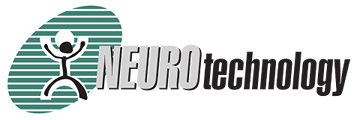Press Release
Neurotechnology Introduces BrainAccess Development Kit for Brain-Computer Interface Applications
Neurotechnology's new EEG solution includes dry-contact electrodes for increased comfort and wi-fi enabled, compact, multi-channel electroencephalographs for a truly portable brain-computer interface system
Vilnius, Lithuania – August 12, 2020 – Neurotechnology today announced the launch of the BrainAccess Development Kit. The kit offers a full dry-contact electroencephalography (EEG) solution including the electrodes, headwear, electroencephalograph, EEG signal acquisition and processing software and brain-computer interface (BCI) example algorithms. The BrainAccess Development Kit can be used to develop applications where a person controls a computer or other device through activities such as eye movements, visual focus, relaxation state or other subtle changes that can be detected in the user's EEG signal patterns.
Conventional EEG uses "wet" electrodes that require gel and scalp preparation for better electrical contact, making it difficult to use outside of a clinical or laboratory environment. Neurotechnology's dry-contact electrodes require no gel and are shape-conforming, resulting in better comfort and electrical contact compared to standard dry-contact electrodes.
"EEG is a highly effective, low-cost method for measuring brain activity in BCI applications due to its non-invasive nature and high temporal resolution," said Dr.Osvaldas Putkis, project lead at Neurotechnology. "However, two things are needed in order for EEG to become practical enough for widespread adoption and everyday BCI use: 1) efficient dry-contact electrodes for measurement and 2) miniaturization of electroencephalographs with a high number of acquisition channels."
BrainAccess MINI is an ultra-portable electroencephalograph offering 16 acquisition channels, wireless connectivity and more than 10-hours of battery-powered operation time. BrainAccess MODULAR electroencephalograph features a modular architecture with 32-128 acquisition channels allowing for high-density electrode coverage of the cerebral cortex.
BrainAccess Development Kit
Neurotechnology's BrainAccess Development Kit comes in two variants: Standard and Extended. The Standard version includes the BrainAccess MINI electroencephalograph and the BrainAccess BAND: headwear with dry-contact electrodes for measuring brain activity over the forehead and occipital regions. A BrainAccess CAP with 16 dry-contact electrodes is another available option for standard coverage of the cerebral cortex.
The Extended version features the BrainAccess MODULAR electroencephalograph with 32 acquisition channels and the BrainAccess CAP with 32 shape-conforming dry-contact electrodes. The number of acquisition channels in BrainAccess MODULAR can be further expanded with expansion modules to up to 128 channels. This kit offers high-density coverage of all cerebral cortex regions offering development capabilities of more elaborate BCI experiments or applications.
BrainAccess Software
The BrainAccess Development Kit comes with all of the necessary software for EEG data acquisition and processing and also features some BCI algorithms. BrainAccess Core Library provides an interface with BrainAccess electroencephalographs and allows for direct access of recorded EEG data. It enables the configuration of acquisition parameters and streaming of EEG data to a computer, and it also provides standard EEG signal processing tools. BrainAccess Viewer is an application with a graphical interface that exposes some of the BrainAccess Core functionality. BrainAccess BCI Library contains BCI example algorithms and samples. The library currently includes three example algorithms:
- The motion classifier algorithm recognizes EEG signal patterns associated with eye blinks, eye movements upwards and downwards and teeth clenching. A sample using this algorithm to control a web browser is included. A user can scroll a page up and down by moving their eyes up and down respectively. They can open a link in the central part of a page by clenching their teeth and can go back to the previous page by double blinking.
- The SSVEP (steady-state-evoked-potential) detector algorithm exposes the user to different frequencies of visual flicker and detects on which flicker the user is visually focusing. A sample is included where the user can select between four different directions when concentrating on any of the four flickering triangles on the screen.
- The alpha detector algorithm estimates the level of alpha brainwaves generated by the user. The level of alpha brainwaves increases when a person is relaxed and has their eyes closed and decreases when a person is in a state of alert concentration. A sample is included where a user can control a computer's sound volume based on their relaxation state.
BrainAccess Core and BrainAccess BCI Library are both accessible via C/C++ and Python APIs and therefore can be easily integrated into various experiments and applications.
About Neurotechnology
Neurotechnology is a developer of high-precision algorithms and software based on deep neural networks and other AI-related technologies. The company was launched in 1990 in Vilnius, Lithuania, with the key idea of using neural networks for various applications, such as biometric person identification, computer vision, robotics and artificial intelligence. Since the first release of its fingerprint identification system in 1991, the company has delivered more than 200 products and version upgrades. More than 3,000 system integrators, security companies and hardware providers in more than 140 countries integrate Neurotechnology's algorithms into their products. The company's algorithms have achieved top results in independent technology evaluations, including NIST MINEX, PFT, FRVT, IREX and FVC-onGoing.
Media Contact
Jennifer Allen Newton
Bluehouse Consulting Group, Inc.
+1-503-805-7540
jennifer (at) bluehousecg (dot) com
